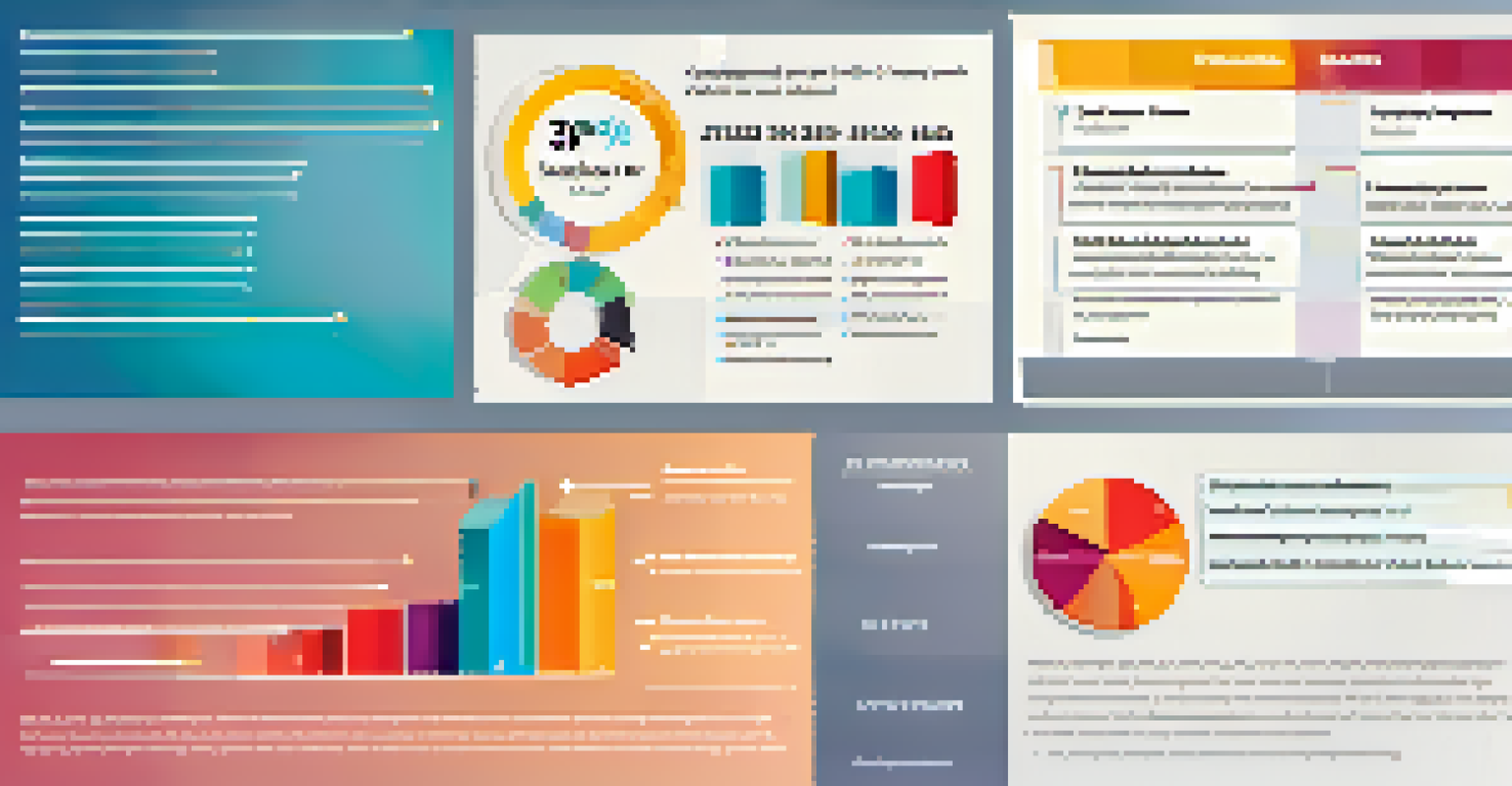Evaluating Learning Outcomes: Metrics and Methods Explained

Understanding Learning Outcomes and Their Importance
Learning outcomes are specific statements that articulate what learners should know or be able to do by the end of an educational experience. They serve as a roadmap for both educators and students, guiding the teaching and learning process. By clearly defining these outcomes, institutions can ensure that their educational goals align with the needs of students and the demands of the job market.
What we learn with pleasure, we never forget.
When evaluating learning outcomes, it's not just about measuring knowledge retention; it's about assessing the application of that knowledge in real-world contexts. This shift in focus allows educators to create more meaningful assessments that reflect true learning. Moreover, understanding the importance of learning outcomes helps in refining curricula, ensuring that students are well-prepared for future challenges.
Ultimately, learning outcomes act as a bridge connecting educational intentions with actual student performance. When effectively communicated, they foster a shared understanding between educators and students, paving the way for enhanced educational experiences. By investing time in defining and evaluating these outcomes, institutions can significantly improve their educational strategies.
Key Metrics for Evaluating Learning Outcomes
To evaluate learning outcomes effectively, it's crucial to use various metrics that provide a comprehensive view of student performance. Common metrics include test scores, assignment completion rates, and participation levels. Each of these metrics offers unique insights, helping educators identify areas of strength and those needing improvement.

Another important metric is student feedback, which can reveal how well students feel they understand the material and what areas they struggle with. Surveys and informal discussions can provide valuable qualitative data that complements quantitative metrics. This combination of data types creates a fuller picture of learning outcomes, allowing for more informed decision-making.
Importance of Learning Outcomes
Learning outcomes provide a roadmap for both educators and students, ensuring educational goals align with student needs and job market demands.
Additionally, tracking long-term success indicators, such as job placement rates or further education enrollment, can provide context for evaluating learning outcomes. These metrics help institutions assess the real-world impact of their programs. By focusing on diverse metrics, educators can ensure a robust evaluation of learning outcomes that drives continuous improvement.
Qualitative vs. Quantitative Methods of Assessment
Evaluating learning outcomes involves both qualitative and quantitative assessment methods, which serve different but complementary purposes. Quantitative methods, such as standardized tests and numerical grades, provide measurable data that is easy to analyze. They can efficiently assess knowledge and skills across large groups of students, making it easier to identify trends and patterns.
Education is not the filling of a pail, but the lighting of a fire.
On the other hand, qualitative methods include interviews, open-ended survey questions, and observations, allowing for deeper insights into the learning process. These methods can capture nuances that numbers alone may miss, such as students' attitudes, motivations, and challenges. By combining both approaches, educators can gain a richer understanding of learning outcomes.
Ultimately, a balanced assessment strategy that incorporates both qualitative and quantitative methods can offer a more holistic view of student learning. This dual approach not only enhances the accuracy of evaluations but also fosters a more supportive learning environment by recognizing diverse learning experiences.
Formative Assessment: A Tool for Continuous Learning
Formative assessment refers to ongoing evaluations that provide feedback during the learning process rather than at its conclusion. This method allows educators to monitor student progress and make necessary adjustments in real-time. By implementing formative assessments, teachers can identify learning gaps and address them before they become more significant issues.
Examples of formative assessments include quizzes, peer reviews, and classroom discussions. These tools encourage active participation and engagement, helping students take ownership of their learning. By regularly assessing understanding, educators can create an adaptive learning environment that caters to individual student needs.
Diverse Metrics for Evaluation
Utilizing a combination of qualitative and quantitative metrics offers a comprehensive view of student performance and enhances decision-making.
Moreover, formative assessments promote a growth mindset among students, emphasizing that learning is a continuous journey. This focus on development rather than merely achieving a grade can boost student motivation and resilience. In essence, formative assessment is a vital strategy for enhancing learning outcomes, ensuring that students are on track to meet their educational goals.
Summative Assessment: Evaluating Overall Achievement
Summative assessment occurs at the end of an instructional period, providing a snapshot of what students have learned. Common forms of summative assessment include final exams, end-of-term projects, and standardized tests. These evaluations help determine whether students have met the learning outcomes set at the beginning of a course or program.
While summative assessments are crucial for certification and progression, they often serve a different purpose than formative assessments. They typically focus on the end result rather than the learning journey. However, they provide essential data that can be used to evaluate the effectiveness of teaching strategies and curricula.
It's important to remember that summative assessments should align with the defined learning outcomes to be truly effective. When designed thoughtfully, these assessments can validate the educational process and help institutions demonstrate accountability. Thus, summative assessments play a key role in evaluating learning outcomes, contributing to the overall improvement of educational practices.
Using Data Analytics to Enhance Learning Outcomes
In today's digital age, data analytics has become a powerful tool for evaluating learning outcomes. By analyzing trends and patterns in student performance data, educators can make informed decisions that enhance teaching and learning. This approach allows for a more personalized learning experience, as educators can tailor their strategies to meet the unique needs of their students.
Data analytics can reveal valuable insights, such as which teaching methods are most effective or which students may need additional support. By leveraging this information, institutions can implement targeted interventions to improve learning outcomes. This data-driven approach not only enhances educational effectiveness but also fosters a culture of continuous improvement.
Stakeholder Involvement Matters
Engaging various stakeholders in evaluating learning outcomes fosters a collaborative approach that enhances educational programs and student success.
Moreover, using data analytics encourages collaboration among educators, as they can share findings and best practices. This collaborative effort can lead to innovative teaching strategies that benefit the entire educational community. In summary, integrating data analytics into the evaluation of learning outcomes has the potential to transform educational practices and drive student success.
The Role of Stakeholders in Evaluating Learning Outcomes
Evaluating learning outcomes is not the sole responsibility of educators; various stakeholders play a crucial role in this process. Students, parents, administrators, and even employers can provide valuable perspectives on the effectiveness of educational programs. By involving these stakeholders, institutions can gain a more comprehensive understanding of learning outcomes.
For instance, student feedback can highlight areas where teaching methods resonate well or fall short. Similarly, parents can offer insights into their children's educational experiences, while employers can share their expectations regarding skills and knowledge. This collaborative approach fosters a sense of community and shared responsibility for student success.

Furthermore, engaging stakeholders in the evaluation process can lead to more relevant and responsive educational programs. By aligning learning outcomes with the needs of all parties involved, institutions can create a more effective and meaningful educational experience. In essence, collaboration among stakeholders is key to successfully evaluating and enhancing learning outcomes.